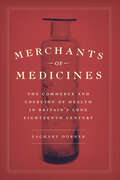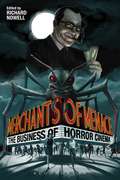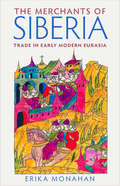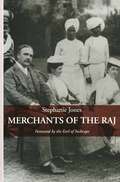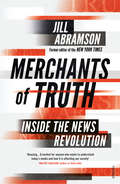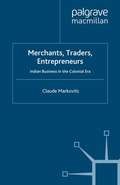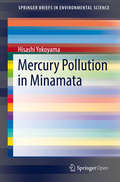- Table View
- List View
Merchants of Medicines: The Commerce and Coercion of Health in Britain’s Long Eighteenth Century
by Zachary DornerThe period from the late seventeenth to the early nineteenth century—the so-called long eighteenth century of English history—was a time of profound global change, marked by the expansion of intercontinental empires, long-distance trade, and human enslavement. It was also the moment when medicines, previously produced locally and in small batches, became global products. As greater numbers of British subjects struggled to survive overseas, more medicines than ever were manufactured and exported to help them. Most historical accounts, however, obscure the medicine trade’s dependence on slave labor, plantation agriculture, and colonial warfare. In Merchants of Medicines, Zachary Dorner follows the earliest industrial pharmaceuticals from their manufacture in the United Kingdom, across trade routes, and to the edges of empire, telling a story of what medicines were, what they did, and what they meant. He brings to life business, medical, and government records to evoke a vibrant early modern world of London laboratories, Caribbean estates, South Asian factories, New England timber camps, and ships at sea. In these settings, medicines were produced, distributed, and consumed in new ways to help confront challenges of distance, labor, and authority in colonial territories. Merchants of Medicines offers a new history of economic and medical development across early America, Britain, and South Asia, revealing the unsettlingly close ties among medicine, finance, warfare, and slavery that changed people’s expectations of their health and their bodies.
Merchants of Medicines: The Commerce and Coercion of Health in Britain’s Long Eighteenth Century
by Zachary DornerThe period from the late seventeenth to the early nineteenth century—the so-called long eighteenth century of English history—was a time of profound global change, marked by the expansion of intercontinental empires, long-distance trade, and human enslavement. It was also the moment when medicines, previously produced locally and in small batches, became global products. As greater numbers of British subjects struggled to survive overseas, more medicines than ever were manufactured and exported to help them. Most historical accounts, however, obscure the medicine trade’s dependence on slave labor, plantation agriculture, and colonial warfare. In Merchants of Medicines, Zachary Dorner follows the earliest industrial pharmaceuticals from their manufacture in the United Kingdom, across trade routes, and to the edges of empire, telling a story of what medicines were, what they did, and what they meant. He brings to life business, medical, and government records to evoke a vibrant early modern world of London laboratories, Caribbean estates, South Asian factories, New England timber camps, and ships at sea. In these settings, medicines were produced, distributed, and consumed in new ways to help confront challenges of distance, labor, and authority in colonial territories. Merchants of Medicines offers a new history of economic and medical development across early America, Britain, and South Asia, revealing the unsettlingly close ties among medicine, finance, warfare, and slavery that changed people’s expectations of their health and their bodies.
Merchants of Medicines: The Commerce and Coercion of Health in Britain’s Long Eighteenth Century
by Zachary DornerThe period from the late seventeenth to the early nineteenth century—the so-called long eighteenth century of English history—was a time of profound global change, marked by the expansion of intercontinental empires, long-distance trade, and human enslavement. It was also the moment when medicines, previously produced locally and in small batches, became global products. As greater numbers of British subjects struggled to survive overseas, more medicines than ever were manufactured and exported to help them. Most historical accounts, however, obscure the medicine trade’s dependence on slave labor, plantation agriculture, and colonial warfare. In Merchants of Medicines, Zachary Dorner follows the earliest industrial pharmaceuticals from their manufacture in the United Kingdom, across trade routes, and to the edges of empire, telling a story of what medicines were, what they did, and what they meant. He brings to life business, medical, and government records to evoke a vibrant early modern world of London laboratories, Caribbean estates, South Asian factories, New England timber camps, and ships at sea. In these settings, medicines were produced, distributed, and consumed in new ways to help confront challenges of distance, labor, and authority in colonial territories. Merchants of Medicines offers a new history of economic and medical development across early America, Britain, and South Asia, revealing the unsettlingly close ties among medicine, finance, warfare, and slavery that changed people’s expectations of their health and their bodies.
Merchants of Menace: The Business of Horror Cinema
by Richard NowellEven though horror has been a key component of media output for almost a century, the genre's industrial character remains under explored and poorly understood. Merchants of Menace: The Business of Horror Cinema responds to a major void in film history by shedding much-needed new light on the economic dimensions of one of the world's most enduring audiovisual forms. Given horror cuts across budgetary categories, industry sectors, national film cultures, and media, Merchants of Menace also promises to expand understandings of the economics of cinema generally. Covering 1930-present, this groundbreaking collection boasts fourteen original chapters from world-leading experts taking as their focus such diverse topics as early zombie pictures, post-WWII chillers, Civil Rights-Era marketing, Hollywood literary adaptations, Australian exploitation, "torture-porn" Auteurs, and twenty-first-century remakes.
Merchants of Menace: The Business of Horror Cinema
by Richard NowellEven though horror has been a key component of media output for almost a century, the genre's industrial character remains under explored and poorly understood. Merchants of Menace: The Business of Horror Cinema responds to a major void in film history by shedding much-needed new light on the economic dimensions of one of the world's most enduring audiovisual forms. Given horror cuts across budgetary categories, industry sectors, national film cultures, and media, Merchants of Menace also promises to expand understandings of the economics of cinema generally. Covering 1930-present, this groundbreaking collection boasts fourteen original chapters from world-leading experts taking as their focus such diverse topics as early zombie pictures, post-WWII chillers, Civil Rights-Era marketing, Hollywood literary adaptations, Australian exploitation, "torture-porn" Auteurs, and twenty-first-century remakes.
The Merchants of Siberia: Trade in Early Modern Eurasia
by Erika MonahanIn The Merchants of Siberia, Erika Monahan reconsiders commerce in early modern Russia by reconstructing the trading world of Siberia and the careers of merchants who traded there. She follows the histories of three merchant families from various social ranks who conducted trade in Siberia for well over a century. These include the Filat'evs, who were among Russia’s most illustrious merchant elite; the Shababins, Muslim immigrants who mastered local and long-distance trade while balancing private endeavors with service to the Russian state; and the Noritsyns, traders of more modest status who worked sometimes for themselves, sometimes for bigger merchants, and participated in the emerging Russia-China trade. Monahan demonstrates that trade was a key component of how the Muscovite state sought to assert its authority in the Siberian periphery. The state’s recognition of the benefits of commerce meant that Russian state- and empire-building in Siberia were characterized by accommodation; in this diverse borderland, instrumentality trumped ideology and the Orthodox state welcomed Central Asian merchants of Islamic faith. This reconsideration of Siberian trade invites us to rethink Russia’s place in the early modern world. The burgeoning market at Lake Yamysh, an inner-Eurasian trading post along the Irtysh River, illuminates a vibrant seventeenth-century Eurasian caravan trade even as Europe-Asia maritime trade increased. By contextualizing merchants and places of Siberian trade in the increasingly connected economies of the early modern period, Monahan argues that, commercially speaking, Russia was not the "outlier" that most twentieth-century characterizations portrayed.
Merchants of the Raj: British Managing Agency Houses in Calcutta Yesterday and Today
by Stephanie JonesMuch has been written about the British experience in India. This book provides a study of British businesses in Calcutta, particularly the managing agency houses. It examines the histories of 15 major managing agencies via the personal experiences of nearly 70 employees.
Merchants of Truth: Inside the News Revolution
by Jill AbramsonMerchants of Truth by Jill Abramson, former editor of The New York Times, is the gripping and definitive in-the-room account of the revolution that has swept the news industry over the last decade and reshaped our world.'A cracking, essential read … [Abramson] knows where most of the bodies are buried and is prepared to draw the reader a detailed map' Guardian'A masterwork ... vastly useful' Financial TimesDrawing on revelatory access, Abramson takes us behind the scenes at four media titans during the most volatile years in news history. Two are maverick upstarts: BuzzFeed, the brain-child of virtuoso clickbait scientist Jonah Perretti, and VICE, led by the booze-fuelled anarcho-hipster Shane Smith. Their viral technology and disregard for the long-established standards of news journalism allow them to build game-changing billion-dollar businesses out of the millennial taste for puppies and nudity.The two others are among the world’s most venerable news institutions: The New York Times, owned and run for generations by the Sulzberger dynasty, and The Washington Post, also family-owned but soon to be bought by the world’s richest merchant of all, Jeff Bezos. Here Abramson reveals first-hand the seismic clashes that take place in the boardrooms and newsrooms as they are forced to choose between their cherished principles – objectivity and impartiality – and survival in a world where online advertising via Facebook and Google seems the only life-raft. We are with the deal-making tycoons, thrusting reporters and hard-bitten editors, the egomaniacs, bullshitters, provocateurs and bullies, as some surf and others drown in the breaking wave of change. And we watch as the survivors confront the horrifying cost of their success: sexual scandal, fake news, the election of President Trump, the shaking of democracy.Exposing the people and decisions that brought us to now, Merchants of Truth is a major book that breaks the ultimate news story of our times.
Merchants, Traders, Entrepreneurs: Indian Business in the Colonial Era
by C. MarkovitsThis book deals with three main aspects of the history of Indian business: The relationship between business and politics, the position of merchants and businessmen in the economy and society of late colonial India, and how particular merchant networks extended the range of their operations to the entire subcontinent and the wider world.
The Merciful Humility of God: The 2019 Lent Book
by Jane WilliamsSt Augustine's insight was that it is only the merciful humility of God that could penetrate our armoured pride. As we follow this book through Lent and through the Biblical narrative what begins to emerge is that God's merciful humility is the source of life. The chapters of Jane Williams's book include: 'Humble Beginnings'; 'How to win friends and influence nobody'; 'Reigning from a tree' and 'Risen and ascended into humility'. Her reflective Lent book will be a trusted guide for anyone seeking a deeper understanding of God's humility during this religious period.
The Merciful Humility of God: The 2019 Lent Book
by Jane WilliamsSt Augustine's insight was that it is only the merciful humility of God that could penetrate our armoured pride. As we follow this book through Lent and through the Biblical narrative what begins to emerge is that God's merciful humility is the source of life. The chapters of Jane Williams's book include: 'Humble Beginnings'; 'How to win friends and influence nobody'; 'Reigning from a tree' and 'Risen and ascended into humility'. Her reflective Lent book will be a trusted guide for anyone seeking a deeper understanding of God's humility during this religious period.
The Merck Druggernaut: The Inside Story of a Pharmaceutical Giant
by Fran HawthorneAn in-depth look at big pharma's flagship company The Merck Druggernaut takes readers inside Merck, the world's second most profitable drug company and maker of the world's bestselling drug, Prilosec. Consistently named one of Fortune magazine's Most Admired Companies, Merck struggles to maintain its reputation for being the most ethical of the big drug makers, refusing to slash research and development budgets in the face of declining profits, falling stock market prices, and questionable accounting. Author Fran Hawthorne, one of the leading journalists covering healthcare, has written an excellent examination of a business paragon with much-needed insight on the cutthroat world of pharmaceuticals. It's a story that will interest the business world as well as consumer and healthcare advocates by detailing the vital issues in medicine and healthcare today. More than just a compelling story of success in a difficult industry, more than simply the biography of one of big business's most recognizable names, The Merck Druggernaut takes a thoughtful look at some of the major issues of our time and the way those issues intertwine with the world of business. Fran Hawthorne (New York, NY) is the Assistant Managing Editor at Crain's New York Business. She has been covering business for more than twenty years for such publications as Fortune, BusinessWeek, and Institutional Investor, with a prevailing interest in healthcare and pharmaceuticals. At Crain's, she spearheads the publication of two to three special healthcare issues per year.
Mercury Pollution in Minamata (SpringerBriefs in Environmental Science)
by Hisashi YokoyamaThis book is open access under a CC BY 4.0 license. It overviews the poisoning which occurred in the 1950s and 1960s among the residents in Minamata who ate seafood contaminated with methylmercury discharged from the chemical factory, Chisso Corporation. It describes the history, symptoms pathogenesis and research on the causal agent, and discusses the responses of Chisso and the national and local governments to the outbreak, the victims, the compensation and environmental restructuring as well as the court ruling on claims. Based on lecture notes from a university course, it includes students’ suggestions for avoiding a repeat of the tragedy. The issue has not been settled yet, and this analysis of the incident provides useful insights into solutions to the current global mercury pollution problem.
The MERge Model for Business Development: The Amalgamation of Management, Education and Research (SpringerBriefs in Business)
by Orit Hazzan Ronit Lis-HacohenThis Brief presents a new model for business development—MERge—to be implemented in practitioners’ professional development in general and in the context of STEM (Science, Technology, Engineering and Mathematics) initiatives, particularly, in industry, educational institutions and public sector organizations. The authors aim to contribute to the field of innovation and entrepreneurship by merging and consolidating different methodologies and insights borrowed from the "meta-professions" (referring to skills that can be expressed meaningfully after one has gained disciplinary and professional knowledge) of management, education, and research. Targeting three key groups—practitioners in industry, academic institutions and public sector organizations—this model proposes that all practitioners can further develop their unique expertise, as well as new skills, while acknowledging and applying the three meta-professions in their initiatives, on-going work and personal lives.The authors acknowledge that in the postmodern era, where barriers between disciplines are falling in every aspect of professional life, managerial, educational and research skills are becoming increasingly essential and interdependent. Featuring case studies that illustrate how the MERge model is implemented in practice, this volume presents practical tools for integrating these key skills in a wide variety of initiatives in business, teaching and research contexts.
The Merger & Acquisition Leader's Playbook: A Practical Guide to Integrating Organizations, Executing Strategy, and Driving New Growth after M&A or Private Equity Deals
by Jeffrey P. Pritchett George B. BradtMake your next merger or acquisition one for the ages Meant to create value potentially fueled by synergies, the reality is that most mergers and acquisitions fail. It&’s estimated that 83% of mergers and acquisitions do not hit their desired results. The Merger & Acquisition Leader&’s Playbook tells you why most mergers fail. More importantly, it tells you how to make your next one a sweeping success. In the book, a team of private equity experts deliver a masterful walkthrough of how to integrate organizations by driving commercial success, instead of focusing purely on cutting costs. Readers will find: Concrete strategies for increasing the odds of success and reducing the risk of failure – of a new merger or acquisition A comprehensive, easily deployed and implemented plan to realize synergies Proven tools, techniques, and tricks of the trade to help leaders stay on top of their latest merger and keep everything on trackA must-read resource for business leaders considering a fresh merger or acquisition, The Merger & Acquisition Leader's Playbook: A Practical Guide to Integrating Organizations, Executing Strategy, and Driving New Growth after M&A or Private Equity Deals will also earn a place in the libraries of investors, agents, corporate service providers, and consultants trying to get two or more businesses to pull in the same direction.
The Merger & Acquisition Leader's Playbook: A Practical Guide to Integrating Organizations, Executing Strategy, and Driving New Growth after M&A or Private Equity Deals
by Jeffrey P. Pritchett George B. BradtMake your next merger or acquisition one for the ages Meant to create value potentially fueled by synergies, the reality is that most mergers and acquisitions fail. It&’s estimated that 83% of mergers and acquisitions do not hit their desired results. The Merger & Acquisition Leader&’s Playbook tells you why most mergers fail. More importantly, it tells you how to make your next one a sweeping success. In the book, a team of private equity experts deliver a masterful walkthrough of how to integrate organizations by driving commercial success, instead of focusing purely on cutting costs. Readers will find: Concrete strategies for increasing the odds of success and reducing the risk of failure – of a new merger or acquisition A comprehensive, easily deployed and implemented plan to realize synergies Proven tools, techniques, and tricks of the trade to help leaders stay on top of their latest merger and keep everything on trackA must-read resource for business leaders considering a fresh merger or acquisition, The Merger & Acquisition Leader's Playbook: A Practical Guide to Integrating Organizations, Executing Strategy, and Driving New Growth after M&A or Private Equity Deals will also earn a place in the libraries of investors, agents, corporate service providers, and consultants trying to get two or more businesses to pull in the same direction.
Merger Arbitrage: How to Profit from Global Event-Driven Arbitrage (Wiley Finance)
by Thomas KirchnerMitigate risk and increase returns with an alternative hedge fund strategy Merger Arbitrage: How to Profit from Event-Driven Arbitrage, Second Edition is the definitive guide to the ins and outs of the burgeoning merger arbitrage hedge fund strategy, with real-world examples that illustrate how mergers work and how to take advantage of them. Author Thomas Kirchner, founder of the Pennsylvania Avenue Event-Driven Fund, discusses the factors that drove him to invest solely in merger arbitrage and other event-driven strategies, and details the methods used to incorporate merger arbitrage into traditional investment strategies. And while there is always a risk that a deal will fall through, the book explains how minimal such risks really are when the potential upside is factored in. Early chapters of the book focus on the basics of the merger arbitrage strategy, including an examination of mergers and the incorporation of risk into the arbitrage decision. Following chapters detail deal structures, financing, and legal aspects to provide the type of in-depth knowledge required to execute an effective investment strategy. The updated second edition stresses new, increasingly relevant information like: Worldwide legal deal regimes UK takeover code UK takeover code global offspring Regulators around the world The book provides clear, concise guidance on critical considerations including leverage and options, shorting stocks, and legal recourse for inadequate merger consideration, allowing readers to feel confident about trying a new investment strategy. With simple benefits including diversification of risk and return streams, this alternative hedge fund strategy has a place in even the most traditional plan. Merger Arbitrage: How to Profit from Event-Driven Arbitrage, Second Edition provides the information that gives investors an edge in the merger arbitrage arena.
Merger Arbitrage: How to Profit from Global Event-Driven Arbitrage (Wiley Finance)
by Thomas KirchnerMitigate risk and increase returns with an alternative hedge fund strategy Merger Arbitrage: How to Profit from Event-Driven Arbitrage, Second Edition is the definitive guide to the ins and outs of the burgeoning merger arbitrage hedge fund strategy, with real-world examples that illustrate how mergers work and how to take advantage of them. Author Thomas Kirchner, founder of the Pennsylvania Avenue Event-Driven Fund, discusses the factors that drove him to invest solely in merger arbitrage and other event-driven strategies, and details the methods used to incorporate merger arbitrage into traditional investment strategies. And while there is always a risk that a deal will fall through, the book explains how minimal such risks really are when the potential upside is factored in. Early chapters of the book focus on the basics of the merger arbitrage strategy, including an examination of mergers and the incorporation of risk into the arbitrage decision. Following chapters detail deal structures, financing, and legal aspects to provide the type of in-depth knowledge required to execute an effective investment strategy. The updated second edition stresses new, increasingly relevant information like: Worldwide legal deal regimes UK takeover code UK takeover code global offspring Regulators around the world The book provides clear, concise guidance on critical considerations including leverage and options, shorting stocks, and legal recourse for inadequate merger consideration, allowing readers to feel confident about trying a new investment strategy. With simple benefits including diversification of risk and return streams, this alternative hedge fund strategy has a place in even the most traditional plan. Merger Arbitrage: How to Profit from Event-Driven Arbitrage, Second Edition provides the information that gives investors an edge in the merger arbitrage arena.
Merger Arbitrage: A Fundamental Approach to Event-Driven Investing (The Wiley Finance Series)
by Lionel Melka Amit ShabiA wave of corporate mergers, acquisitions, restructuring, and similar transactions has created unprecedented opportunities for those versed in contemporary risk arbitrage techniques. At the same time, the nature of the merger wave has lent such transactions a much higher degree of predictability than ever before, making risk arbitrage more attractive to investors. Surprisingly, there is little transparency and instruction for investors interested in learning the latest risk arbitrage techniques. Merger Arbitrage – A Fundamental Approach to Event-Driven Investing helps readers understand the inner workings of the strategy and hedge funds which engaged in this investment strategy. Merger arbitrage is one of the most commonly used strategies but paradoxically one of the least known. This book puts it in the spotlight and explains how fund managers are able to benefit from mergers and acquisitions. It describes how to implement this strategy, located at the crossroad of corporate finance and asset management, and where its risks lie through numerous topical examples. The book is split into three parts. The first part, examining the basis of merger arbitrage, looks at the key role of the market in takeover bids. It also assesses the major changes in the financial markets over recent years and their impact on M&A. Various M&A risk and return factors are also discussed, alongside the historical profitability of merger arbitrage, the different approaches used by fund managers and the results of academic studies on the subject. The second part of the book deals with the risk of an M&A transaction failing in terms of financing risk, competition issues, the legal aspects of merger agreements and administrative and political risks. The third part of the book examines specificities of M&A transactions, comprehensively covering hostile takeovers and leveraged buyouts. Each part contains many recent examples and case studies in order to show how the various theories and notions are put into practice. From researching prospects and determining positions, to hedging and trading tactics, Lionel Melka and Amit Shabi present the full complement of sophisticated risk arbitrage techniques, making Merger Arbitrage a must read for finance and investment professionals who want to take advantage of the nearly limitless opportunities afforded by today's rapidly changing global business environment. The book builds on its authors’ diverse backgrounds and common experience managing a merger arbitrage fund, providing readers with an enriching inside view on M&A operations.
Merger Control in the EU and Turkey: A Comparative Guide
by Fevzi Toksoy Bahadir Balki Hanna StakheyevaAs a country on the way to integration with the European Union (EU), Turkey has been following EU principles in establishing and improving its merger control regime, as well as overall competition law, keeping pace with changes in relevant EU legislation and case law. However, as is to be expected, specific adjustment needs engender significant differences in the two regimes. This book presents, for the first time, a description and analysis of the relationship between the EU and Turkish merger control law and practice. The authors—all three both practicing lawyers and academicians in Turkey—focus on comparing substantive, procedural and jurisdictional issues and draw parallels on their regulation in the two jurisdictions. These matters include the following: determining whether a transaction shall be regarded as a notifiable merger, hence be subject to control; financial thresholds used for allocating jurisdictions; extraterritoriality of merger control; relationship between the significant impediment to effective competition (SIEC) test and the dominance test; determination of the relevant market; techniques used for assessment of horizontal and non-horizontal mergers; notification requirements; procedural duties of competition authorities in relation to remedies; third-party rights; gun-jumping fines and other sanctions for failure to comply with merger control requirements; and peculiarities of assessment of mergers in the big data world. Each chapter provides an overview of the respective issues in the EU and Turkey, projecting a clear understanding of the main similarities and differences in the two regimes. A notable feature is an in-depth analysis of applicable case law concerning each issue, with most of the Turkish decisions available in English for the first time. In addition to these practical issues, the book’s comparative approach will prove to be of great value. With its clear answers to questions about what transactions are subject to merger control, what criteria are used in assessing those transactions, and the main issues that a foreign company should be aware of while merging with another foreign company with effect in Turkey and/or EU, the book will be of immeasurable value for lawyers and their business clients dealing with multijurisdictional merger cases. Interested academics and policymakers will also find much here to attract their attention.
Merger Control in the EU and Turkey: A Comparative Guide (International Competition Law Series)
by Fevzi Toksoy Bahadir Balki Hanna StakheyevaAs a country on the way to integration with the European Union (EU), Turkey has been following EU principles in establishing and improving its merger control regime, as well as overall competition law, keeping pace with changes in relevant EU legislation and case law. This book presents, for the first time, a description and analysis of the relationship between the EU and Turkish merger control law and practice. The second edition of the book considers the legislative changes that occurred in 2020-2021, including the reform of the Turkish Competition Law which introduced the significant impediment to effective competition (SIEC) test into the Turkish concentration control. The authors—all three, both practicing lawyers and academicians in Turkey—focus on comparing substantive, procedural and jurisdictional issues and draw parallels on their regulation in the two jurisdictions. These matters include the following: determining whether a transaction shall be regarded as a notifiable merger, hence be subject to control; financial thresholds used for allocating jurisdictions; extraterritoriality of merger control; relationship between the SIEC test and the dominance test; determination of the relevant market; techniques used for assessment of horizontal and non-horizontal mergers; notification requirements; procedural duties of competition authorities in relation to remedies; third-party rights; gun-jumping fines and other sanctions for failure to comply with merger control requirements; and peculiarities of assessment of mergers in the Big Data world. Each chapter provides an overview of the respective issues in the EU and Turkey, projecting a clear understanding of the main similarities and differences in the two regimes. A notable feature is an in-depth analysis of applicable case law concerning each issue, with most of the Turkish decisions available in English for the first time. The book’s comparative approach will prove to be of great value. With its clear answers to questions about what transactions are subject to merger control, what criteria are used in assessing those transactions, and the main issues that a foreign company should be aware of while merging with another foreign company with effect in Turkey and/or EU, the book will be of immeasurable value for lawyers and their business clients dealing with multijurisdictional merger cases. Interested academics and policymakers will also find much here to attract their attention.
Merger Control, National Security, and Foreign Direct Investment Screening: A Comparative Perspective
by Ioannis KokkorisThe Covid-19 pandemic, the significant expansion of the Chinese investment abroad, and recent geo-political tensions have all served to strengthen national security considerations in merger control and foreign direct investment (FDI) processes. Against this backdrop, Merger Control, National Security, and Foreign Direct Investment Screening: A Comparative Perspective provides a comprehensive exploration of the intricate interplay between national security, foreign direct investment, and competition policy in an increasingly interconnected global economy. Central to the book's analysis is the exploration of FDI screening mechanisms from a national security perspective as they apply to Merger and Acquisition (M&A) transactions. Spanning a wide array of jurisdictions, industries, and policy contexts, including case studies from major economies such as the European Union, the United Kingdom, the United States, and China, the book examines how lawmakers navigate protecting their strategic sectors while promoting a welcoming environment for investors. It also showcases how competition authorities grapple with incorporating broader societal goals and national security concerns into merger control assessments. Merger Control, National Security, and Foreign Direct Investment Screening scrutinizes the challenges of balancing these objectives while maintaining the integrity of competition law principles and avoiding undue political influence. It offers a thought-provoking and timely guide for policymakers, practitioners, scholars, and stakeholders seeking to navigate the intricacies of global economic interdependence without dismissing national interests.
Merger Control, National Security, and Foreign Direct Investment Screening: A Comparative Perspective
by Ioannis KokkorisThe Covid-19 pandemic, the significant expansion of the Chinese investment abroad, and recent geo-political tensions have all served to strengthen national security considerations in merger control and foreign direct investment (FDI) processes. Against this backdrop, Merger Control, National Security, and Foreign Direct Investment Screening: A Comparative Perspective provides a comprehensive exploration of the intricate interplay between national security, foreign direct investment, and competition policy in an increasingly interconnected global economy. Central to the book's analysis is the exploration of FDI screening mechanisms from a national security perspective as they apply to Merger and Acquisition (M&A) transactions. Spanning a wide array of jurisdictions, industries, and policy contexts, including case studies from major economies such as the European Union, the United Kingdom, the United States, and China, the book examines how lawmakers navigate protecting their strategic sectors while promoting a welcoming environment for investors. It also showcases how competition authorities grapple with incorporating broader societal goals and national security concerns into merger control assessments. Merger Control, National Security, and Foreign Direct Investment Screening scrutinizes the challenges of balancing these objectives while maintaining the integrity of competition law principles and avoiding undue political influence. It offers a thought-provoking and timely guide for policymakers, practitioners, scholars, and stakeholders seeking to navigate the intricacies of global economic interdependence without dismissing national interests.
Merger Endgames, Strategien für die Konsolidierungswelle
by Graeme Deans Fritz Kröger Stefan ZeiselWie werden Fusionsbewegungen verlaufen? Gibt es Gesetzmäßigkeiten für alle Branchen? Eine umfassende Studie erbrachte folgende Erkenntnis: Die Bewegungen in jedem Industriezweig folgen einem bestimmten Muster. Ist innerhalb einer Branche der Grad der Konsolidierung bestimmt, so lassen sich die künftigen Fusionsbewegungen genau vorhersagen und optimale Strategien für einzelne Teilnehmer ableiten. Eine originelle und spannende Lektüre, mit vielen nützlichen Erkenntnissen und Empfehlungen.
The Merger Mindset: How to Get It Right in the High-Stakes World of Mergers, Acquisitions, and Divestitures
by Constance Dierickx Linda HenmanBreaking Up Is Hard to Do offers a unique perspective for leaders—those executives whose companies, reputations, and futures will thrive or fail because of a deal or a series of deals. This book for leaders helps decision-makers deal with the powerful undercurrents and interpersonal dynamics at play in every deal, and no one is more qualified to write it than Constance Dierickx and Linda Henman. Other books on mergers, acquisitions, and divestitures overwhelmingly have one characteristic in common: they’re technical. Attorneys write books about the legal and contractual aspects of deals; project management experts write from the point of view of managing tasks and schedules; and investment bankers write about valuation and negotiation. Breaking Up Is Hard to Do presents an amalgamation of what Drs. Dierickx and Henman have observed—and in many cases, helped to create—in more than 65 cumulative years of consulting with Fortune 500 companies, privately-held firms, family-owned businesses, and military organizations. Their in-the-trenches experiences spurred them to arrive at this premise: To position their organizations for more success, leaders can’t shy away from the high stakes, tough decisions about their futures. This book maps the key steps in the M & A journey. It takes the reader through how to make the decision to grow acquisitively, identify roadblocks and typical wrong turns, and ultimately shows how to unlock their decision-making potential while navigating an increasingly uncertain world. Through compelling stories and surprising research findings, readers will discover that there’s much more to the decision-making that drives M & A deals than they ever imagined, and they will come away with tools to help them deepen their understanding of what it takes to succeed. A fascinating read, the text weaves lessons that surface from the stories with highly pragmatic advice about suggested mindset, checklists, processes, and diagnostic tools. Readers will understand that while M & A deals aren’t simple, leaders don’t have to overly complicate them either. Instead, they can simplify the process if they remember hope shouldn’t serve as a strategy, and they can’t abdicate or delegate their leadership responsibilities. The lessons from mergers and acquisitions are critical to those considering a deal, but applied elsewhere, they have equal value, even though noticing them takes more effort. This is the essence of leadership: doing the hard work of ensuring that the gulf between strategy and tactics does not lead to either over simplification or needless complexity.
